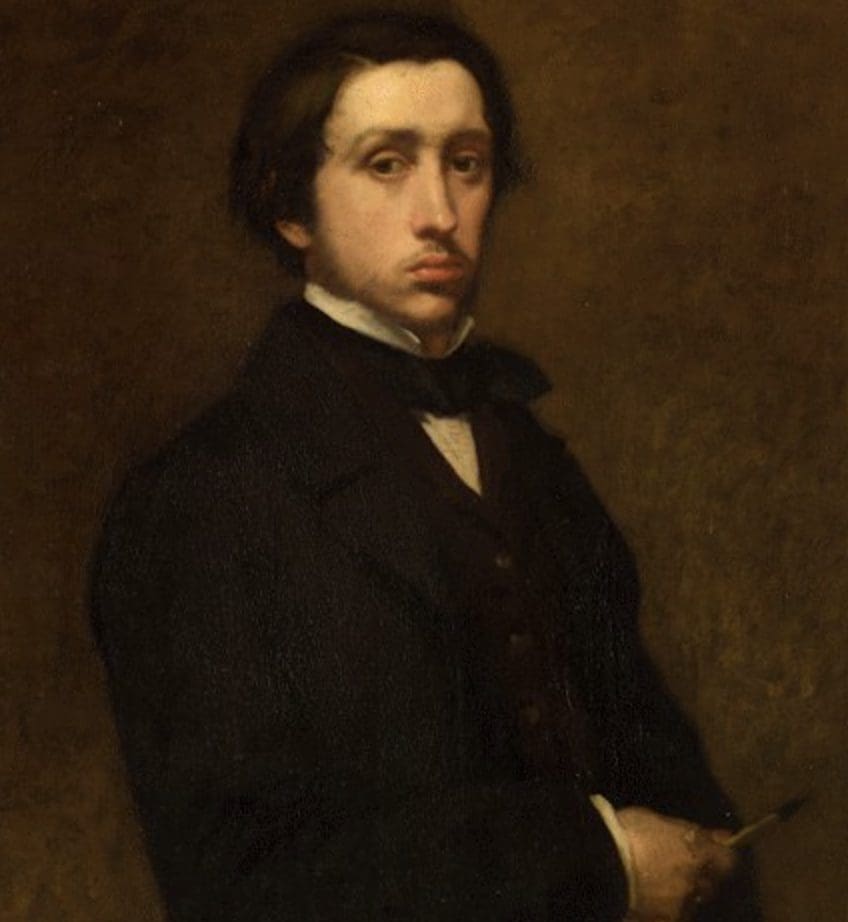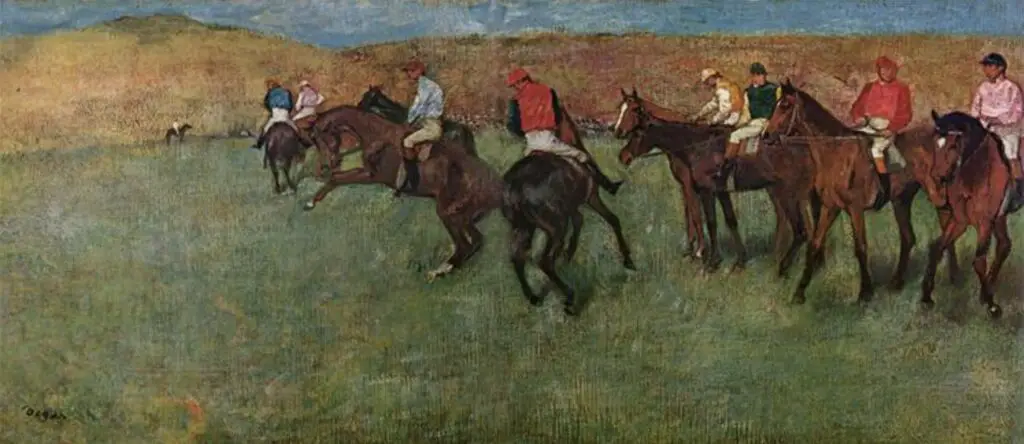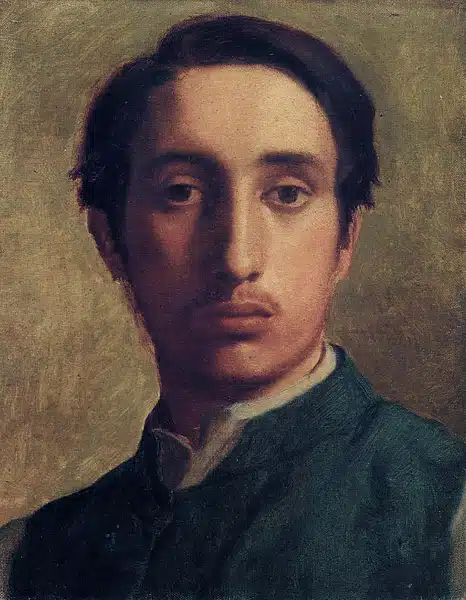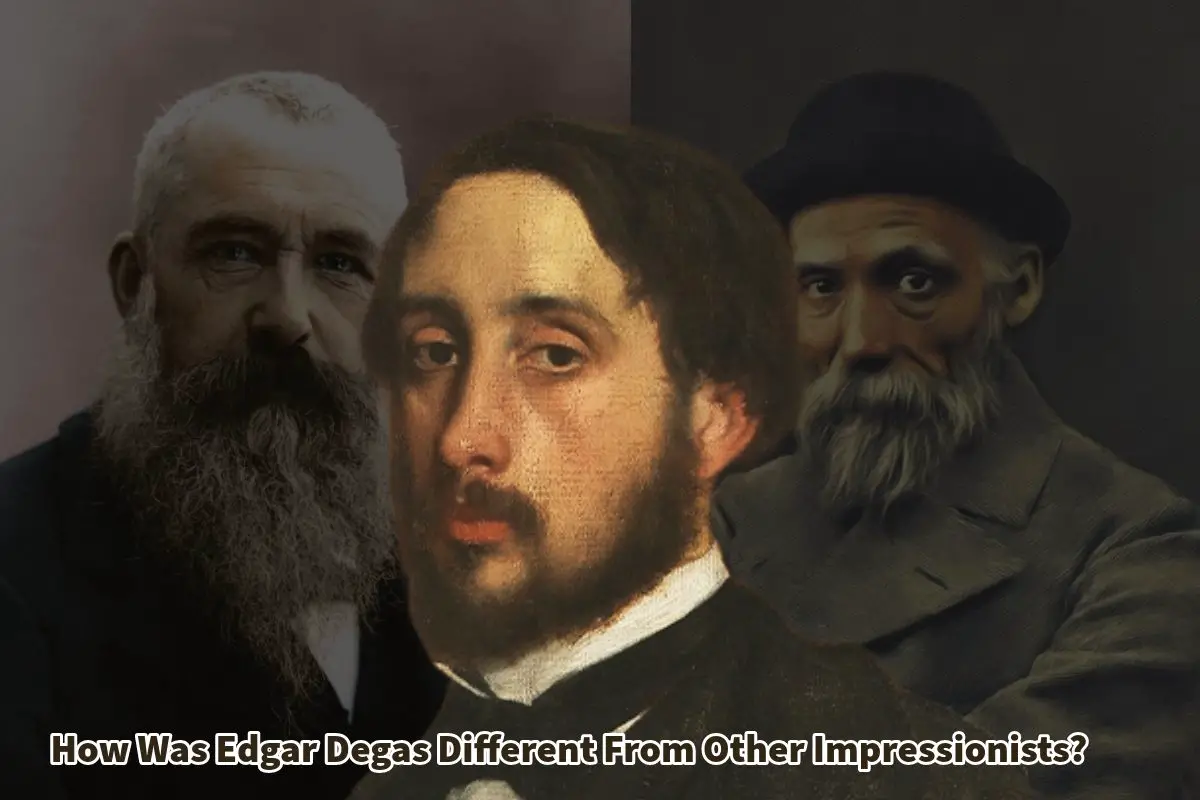As Nada pointed out, Degas is generally categorized as an Impressionist. However, he diverged from many of his Impressionist contemporaries in significant ways.
Unlike artists like Monet and Renoir, who preferred painting en plein air, Degas opted for the controlled environment of his studio. He was also meticulous in his creative process, often sketching his compositions before painting them on canvas. Despite being commonly associated with the Impressionist movement, Degas identified himself more as a Realist or an Independent, and he didn’t readily embrace the Impressionist label.
Table of Contents
- How Was Edgar Degas Different From Other Impressionists?
- Edgar Degas – The Reluctant Impressionist
- Frequently Asked Questions
- Related Questions
How Was Edgar Degas Different From Other Impressionists?
When one thinks of Impressionism, the radiant landscapes of Claude Monet or the dappled light in Pierre-Auguste Renoir’s portraits might come to mind. However, not all artists within this groundbreaking 19th-century art movement followed the same creative compass.
One such enigma was Edgar Degas, a Paris-born artist whose approach to Impressionism was markedly different from his peers.

Here are some ways that Edgar Degas Was different from other impressionists during his time
Working Indoors Vs. Outdoors: An Artistic Choice
Unlike many of his contemporaries who celebrated ‘plein air’ (outdoor) painting, Degas preferred the controlled environment of his studio.
Monet, Renoir, and other Impressionists often painted “en plein air,” capturing the effects of natural light and atmosphere directly onto their canvases. Degas, in contrast, was meticulous and exacting in his work.
In reflecting upon this, Edgar Degas said:
“No art is less spontaneous than mine. What I do is the result of reflection and the study of the great masters.”
Edgar Degas
Degas often made detailed drawings before painting, ensuring each element was carefully considered and placed. This systematic approach was quite the opposite of his peers’ spontaneous, almost effervescent technique.
This in-studio work gave him greater control over lighting conditions, allowing for more academic rigor in portraying his subjects.
Modern Subjects, Traditional Techniques
Yet, despite his unique method, Degas was a pivotal figure within the Impressionist movement. He was one of its founders and participated in almost all its exhibitions.
Degas found common ground with the Impressionists in their shared interest in modern, everyday life. While Monet painted haystacks and water lilies, Degas immortalized ballet dancers, horse races, and scenes from urban life.
His painting “At the Races: Before the Start” is an exquisite example. It captures the restless activity of horses and their jockeys, set against a background of lush fields.

In speaking of all his paintings of the dancers, Edgar Degas said:
“People call me the painter of dancing girls. It has never occurred to them that my chief interest in dancers lies in rendering movement and painting pretty clothes.”
Edgar Degas
In this quote, Edgar Degas shows us how organized he was with his artwork, period. He didn’t paint anything. He thought it through.
Unlike his peers, who were more fluid in their brushwork, Degas leaned towards clean lines and meticulous detailing, reminiscent of his academic training. His formal technique captured contemporary scenes, thus blending the new and the old singularly.
The Influence Of Photography
Another aspect that set Degas apart was his profound interest in the then-emerging field of photography. He was mainly influenced by the pioneering work of Eadweard Muybridge, whose sequential photographs of a galloping horse substantially impacted Degas’s depictions of movement.
Muybridge’s revolutionary work, published in Paris in 1874, offered an analytical look at motion, allowing artists to understand the dynamics of natural actions in a previously impossible way.
Degas embraced this new technology as an additional tool for study and analysis rather than a threat to traditional art forms. While other artists viewed photography with suspicion or indifference, Degas used it as a supplementary lens to observe and portray the world.
It’s also worth noting that his choice of subjects, like the theater and ballet, lent themselves well to the ‘freeze-frame’ quality that photography offered.
Edgar Degas – The Reluctant Impressionist
Interestingly, Degas himself was ambivalent about being labeled an Impressionist. He preferred to call himself a “Realist” or “Independent.” This self-identification resonates with his art, which often seems like a synthesis of traditional academic art and modern subject matter.

While he did share the Impressionist interest in capturing fleeting moments of contemporary life, his way of rendering these moments was far removed from the free brushstrokes and color theories often associated with Impressionism.
Degas’s focus on indoor scenes, particularly those of theaters and cafés, was another divergence. He took advantage of artificial light to enhance the contours and forms of his figures, adding a layer of drama and intensity.
This approach showcased his academic roots, which never entirely left him, even as he ventured into avant-garde territories.
Edgar Degas was undoubtedly a central figure in the Impressionist movement, but his path was uniquely his own. Whether through his preference for studio work over plein-air painting, his meticulous pre-drawing, his modern-day subjects rendered through academic techniques, or his early adoption of photographic ideas, Degas charted a course that set him apart from his contemporaries.
His unwillingness to fully embrace the label ‘Impressionist’ is perhaps the most telling testament to his individuality. Degas was an artist caught between two worlds—the traditional and the modern, the academic and the innovative—and precisely this tension makes his work so compelling.
Through his distinct approach, Degas expanded the boundaries of Impressionism, proving that even within a revolutionary movement, there is room for diverse voices and visions.
Anita Louise Art is dedicated to art education, great artists, and inspiring others to find and create their art. We love art that uplifts and inspires. #ArtToMakeYouSmile! #ArtToMakeYouHappy!
If you want to see any of my art, you can find out more by clicking here. If you are interested in what inspires me and my paintings, you can discover more by clicking here.
We have a free newsletter and would love you to be part of our community; you can subscribe to the newsletter by clicking here. I would be happy to talk to you if you have any questions. You can reach me, Anita, by clicking here.
Subscribe to our Anita Louise Art YouTube Channel with great videos and information by clicking here.
Join us for our podcast “5 Minutes With Art.” Spend just 5 minutes a week with us to discover and learn about great art and artists. You can find out more about our podcast by clicking here.
Frequently Asked Questions
Was Edgar Degas a true Impressionist, or did he identify with a different artistic movement?
Degas is often associated with the Impressionist movement, but he personally identified more with Realism and considered himself an Independent artist. This sets him apart from many of his Impressionist counterparts.
How did Edgar Degas differ in his approach to painting from other Impressionists like Monet and Renoir?
Unlike Monet and Renoir, who favored painting outdoors (en plein air), Degas chose the controlled setting of his studio. This preference for controlled environments was a distinctive departure from the typical Impressionist technique.
What was Degas’s creative process, and how did it differ from other Impressionists?
Degas was known for his meticulous creative process. He often sketched and planned his compositions meticulously before translating them onto canvas. This methodical approach contrasted with the spontaneous techniques of many Impressionists.
Did Degas share the same interest in landscape painting as other Impressionists?
Unlike his Impressionist peers who frequently painted landscapes, Degas was more focused on depicting urban life, ballet scenes, and the human figure. This thematic difference set him apart from the typical subjects of Impressionist art.
How did Degas’s choice of subjects differ from other Impressionists?
While Impressionists often painted landscapes and leisure activities, Degas focused on scenes of modern urban life, particularly capturing the world of ballet dancers and the theater. This thematic distinction marked his unique contribution to the art movement.
Did Edgar Degas exhibit with the Impressionists or participate in their group exhibitions?
Although associated with the Impressionists, Degas did not consistently exhibit in their group shows. He preferred showcasing his work independently or with other art groups, reinforcing his inclination towards independence in both style and exhibition.
How did Degas’s attitude toward the label “Impressionist” differ from his contemporaries?
Degas was less inclined to embrace the term “Impressionist” for himself. While his contemporaries readily identified with the label, Degas resisted categorization, emphasizing his personal artistic identity as a Realist and an Independent.
In terms of technique, how did Degas differ from other Impressionists?
Degas’s technique involved a blend of meticulous planning and execution. His detailed sketches and studies set him apart from the more spontaneous and quickly executed works of some Impressionists, showcasing his distinctive approach to painting.
Were there any specific mediums or materials that set Degas apart from other Impressionists?
Degas experimented with various mediums, including pastels, and often combined them in innovative ways. His versatility in the choice of materials and techniques distinguished him from the more traditional methods employed by some of his Impressionist counterparts.
Did Edgar Degas have a different perspective on the role of art in society compared to other Impressionists?
Degas had a more critical and realistic perspective on the societal role of art. While some Impressionists aimed to capture fleeting moments and sensations, Degas often delved into the social and psychological aspects of his subjects, reflecting a different philosophical approach to art within the movement.
Related Questions
What Was The Focus Of Renaissance Art?
The focus of Renaissance art was on the classics of Greek and Rome, humanist philosophy, and the study of the human figure. Realism was also an essential part of renaissance art. The great artists of the Renaissance also became great anatomists and studied human beings.
By clicking here, you can learn more by reading What Was The Focus Of Renaissance Art?.
What Is The Importance Of Art From The Renaissance Period?
Renaissance art is essential as it was a time of rebirth and discovery. Artists like Leonardo da Vinci, Michelangelo, and Raphael were at the forefront of that change, creation, and discovery. Renaissance art has influenced art and artists for many centuries and continues to influence artists today.
By clicking here, you can learn more by reading What Is The Importance Of Art From The Renaissance Period?.
Early Renaissance Vs. High Renaissance Art Explained
Early Renaissance and High Renaissance are both periods of the art of the Renaissance era. The entire Renaissance era shared a lot of the same characteristics. The High Renaissance was dominated by three major artists: Leonardo da Vinci, Michelangelo, and Raphael.
By clicking here, you can learn more by reading Early Renaissance Vs. High Renaissance Art Explained.


